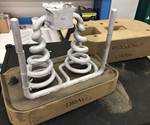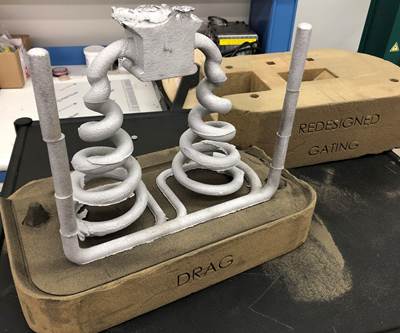The trade-off that users of additive manufacturing tend to take for granted is geometry versus material familiarity. 3D printing makes possible intricate geometries that could not be achieved without it, and even makes these complex forms easy to realize. However, the material properties are those that come from the AM process — the aluminum alloy produced through laser powder bed fusion will differ in its microstructure from a comparable alloy used in, say, casting. And processes such as casting are what engineers are familiar with and what engineering certifications often expect.
So why not cast the part? That is the question investment casting provider Aristo Cast has been asking with increasing frequency. Casting can be used in conjunction with 3D printing to leverage the strengths of both processes. CEO Jack Ziemba is leading the company in the development and application of a technique he calls PICS, for “printed investment casting shell.” In this method of casting, a temporary ceramic shell 3D printed to give the part its shape is later dissolved out of the metal casting it was used to form. The result is a part with the geometric intricacy of additive manufacturing using the alloys and material properties expected of casting.

An illustration of the PICS process. A metal part that might otherwise be too complex for investment casting can be made with a sacrificial 3D printed ceramic tool, such as the one seen here in cutaway. Molten metal is poured into the ceramic shell. The metal solidifies, potentially trapping the shell inside, but the ceramic can then be dissolved away using a solution of potassium hydroxide.
The company has had enough success applying PICS that Ziemba now bristles when he hears the assertion that AM is able to achieve geometries casting cannot. Referring to perhaps the best-known example of a geometrically intricate production part produced with AM, Ziemba says, “I believe we could cast the GE Aviation fuel nozzle. I have asked about getting the design file; I hope we can one day prove this.”
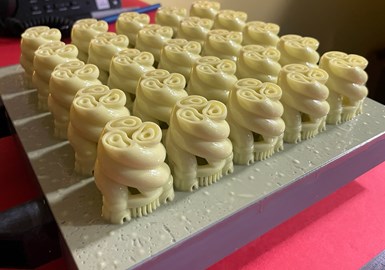
Ceramic shells are 3D printed in batches. This build was stopped unfinished for the sake of this illustration. The complete 3D printing cycle to make this batch of shells would take 8 to 9 hours.
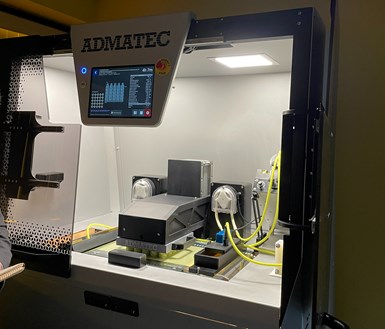
The Admatec machine 3D prints with ceramic by transporting the material to the part in slurry form on a conveyor. A UV light source solidifies the entire layer at once.

Jack Ziemba has devoted his working life to casting. The possibilities have changed with advancing technology, he notes. Additive has been an important part of this. Aristo Cast uses other 3D printing platforms to make patterns, and to make molds and cores in sand. The PICS process using ceramic is the latest step in casting and additive working together.
Aristo Cast’s process using 3D printing is similar to traditional investment casting, but it avoids an initial step. Investment casting typically begins with a wax pattern, and a ceramic shell is allowed to form around this pattern by dipping it in a slurry. During casting, the shell contains the metal as the wax melts away. The PICS process skips the wax pattern — the ceramic shell is 3D printed directly. Aristo Cast does this using an additive system from Admatec.
The Admatec machine uses digital light processing to 3D print with ceramic material. Ceramic in slurry form is delivered on a continuous conveyor to a UV light source that fuses the material to the part layer by layer. Users of this machine include manufacturers of ceramic implants, but Ziemba says finding this machine and seeing how it could be applied to sacrificial casting tooling was an important discovery that made the AM-enabled investment casting process possible. Aristo Cast uses the machine to print with fused silica, a ceramic material that breaks down in potassium hydroxide and water after casting is done, so the casting remains clean and unharmed while the ceramic entirely dissolves away.

Even with the 3D printed ceramic shells, dipping in ceramic slurry (seen here) is still a necessary step for reinforcement. The open 3D printed shell might be plugged with wax for this step.

Another example of a cast part with internal complexity, and the 3D printed ceramic shell used to produce it.
The result is far more than just a different way to do investment casting, Ziemba notes. A wax pattern is limited when it comes to the potential for complexity — too much detail, and the ceramic will not be able to coat it sufficiently during dipping. A ceramic form directly 3D printed does not have this limitation. Ziemba showed the example of a cast metal part with intricate internal surface details in the shape of gyroids. That mathematical form, the gyroid, is a shape found in nature that lends itself well to devices such as heat exchangers. The common assumption is that 3D printing alone is the only way to realize manufactured forms taking advantage of the surface-area benefit of gyroids. Aristo Cast argues that 3D printing is indeed vital, but the company is demonstrating that a much older and more established process — casting — can also be used to produce these complex geometries.
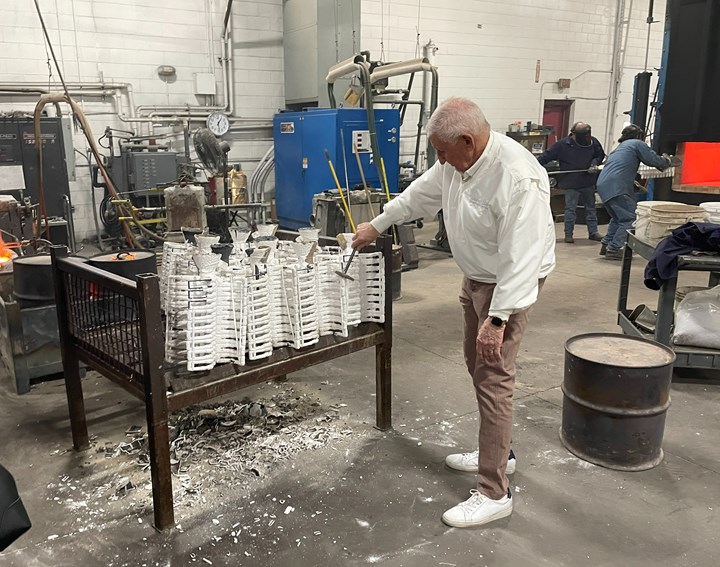
After castings have cooled, the ceramic can be dissolved, but it can also be removed manually where exposed. The ceramic shells seen here were made conventionally, not through 3D printing, but the principle is the same. Ziemba, seen here hammering, wears white in the shop to emphasize the cleanness of the facility.
Related Content
What Does Additive Manufacturing Readiness Look Like?
The promise of distributed manufacturing is alluring, but to get there AM first needs to master scale production. GKN Additive’s Michigan facility illustrates what the journey might look like.
Read MoreHow to Build 10,000+ Shot Molds in Hours
Rapid tooling isn’t so rapid when it takes days to 3D print a metal mold, and then you still must machine it to reach the necessary tolerances. With Nexa3D’s polymer process you can print a mold in hours that is prototype or production ready and can last for more than 10,000 shots.
Read MoreMultimaterial 3D Printing Enables Solid State Batteries
By combining different 3D printing processes and materials in a single layer, Sakuu’s Kavian platform can produce batteries for electric vehicles and other applications with twice the energy density and greater safety than traditional lithium-ion solutions.
Read More10 Important Developments in Additive Manufacturing Seen at Formnext 2022 (Includes Video)
The leading trade show dedicated to the advance of industrial 3D printing returned to the scale and energy not seen since before the pandemic. More ceramics, fewer supports structures and finding opportunities in wavelengths — these are just some of the AM advances notable at the show this year.
Read MoreRead Next
Is AM in Competition With Conventional Manufacturing? Tooling Is on Conventional’s Side
Recent articles consider the other way additive manufacturing is advancing production: not by 3D printing parts, but in the ways 3D printed tooling makes casting, machining, molding and other processes better.
Read MoreAdditive Manufacturing and Metal Casting
How is additive manufacturing disrupting metal casting? A hybrid approach to consider.
Read More3D Printed Heat Exchanger Uses Gyroids for Better Cooling | The Cool Parts Show #43
Replacement heat exchanger for a helicopter is half the size and delivers 4× the cooling, thanks to a geometry that could only be made via additive manufacturing.
Read More



